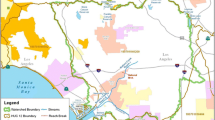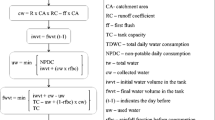Abstract
Rainwater harvesting (RWH) systems are one of the most promising technologies for water supply, but the economic viability often barricades their implementation. To assess the economic viability of decentralized RWH systems at a regional level, this paper develops a generic method to investigate the effect of variations in building characteristics on the economic performance of rainwater harvesting systems in regions with fixed water tariffs and rainfall distribution characteristics. We simulated the financial efficiency (expressed as a benefit-cost ratio) of a large number of decentralized RWH systems in Guangzhou, China. We found that the financial efficiency of the RWH systems is closely related to the catchment fraction (i.e., the ratio of rainfall catchment surface to total floor area). Based on this dimensionless parameter, we derived explicit equations expressing the financial efficiency of RWH systems using a nonlinear regression method. In addition, we validated the analytical equations by the root mean square error test, normality test, and error distribution test. This analytical solution provides a simple and generic method for forecasting the investment potential of rainwater harvesting systems. This methodology can also be adapted to other regions where the variations in local water price and rainfall data need to be considered.







Similar content being viewed by others
Data Availability
All relevant data to support the results of this study are included in the paper or its Supplementary Information.
References
Aladenola OO, Adeboye OB (2010) Assessing the potential for rainwater harvesting. Water Resour Manag 24(10):2129–2137. https://doi.org/10.1007/s11269-009-9542-y
Bashar MZI, Karim MR, Imteaz MA (2018) Reliability and economic analysis of urban rainwater harvesting: a comparative study within six major cities of Bangladesh. Resour Conserv Recycl 133:146–154
Campisano et al (2017) Urban rainwater harvesting systems: research, implementation and future perspectives. Water Res 115:195–209
Chen W, Gao W, Wei X et al (2022) Dimensionless parameter method for evaluating decentralized water reuse systems in buildings. Sustain Cities Soc 76:1–16. https://doi.org/10.1016/j.scs.2021.103391
Eduardo LS, Enedir G (2012) Potable water savings by using rainwater for non-potable uses in houses. Water 4(3):607–628. https://doi.org/10.3390/w4030607
Emami JM, Ghaderi SF, Sangari MS (2020) Integrating energy and water optimization in buildings using multi-objective mixed-integer linear programming. Sustain Cities Soc 62, Article 102409.
Fernandes S, Bonfante MC, de Oliveira CT, Maldonado MU, Campos LMS (2020) Decentralized water supply management model: a case study of public policies for the utilization of rainwater. Water Resour Manag 34(9):2771–2785. https://doi.org/10.1007/s11269-020-02575-8
Fernando C, Manuel K, Jochen H (2020) A multi-parameter method to quantify the potential of roof rainwater harvesting at regional levels in areas with limited rainfall data. Resour Conserv Recycl 161:1–13. https://doi.org/10.1016/j.resconrec.2020.104959
Guangzhou Construction Project Cost Management Station, Inc. (GCPCMS) (2019) Cost information of Guangzhou in the third quarter of 2019. http://www.gzgczj.com (in Chinese). Accessed 1 July 2020
Kolavani NJ, Kolavani NJ (2020) Technical feasibility analysis of rainwater harvesting system implementation for domestic use. Sustain Cities Soc 62, Article 102340
Ministry of Housing and Urban-Rural Construction of the People’s Republic of China (2010) Economic evaluation methods and parameters of municipal public facilities construction projects. China Planning Press, Beijing, pp 1–184 (in Chinese)
Mitchell VG (2007) How important is the selection of computational analysis method to the accuracy of rainwater tank behaviour modeling. Hydrol Process 21(21):2850–2861
Morales-Pinzón T, Lurueña R, Gabarrell X, Gasol CM, Rieradevall J (2014) Financial and environmental modelling of water hardness — implications for utilising harvested rainwater in washing machines. Sci Total Environ 470–471:1257–1271
Moriasi et al (2007) Model evaluation guidelines for systematic quantification of accuracy in watershed simulations. Trans ASABE 50:885–900
Muhammad M, Monzur AI (2017) Generalized equations, climatic and spatial variabilities of potential rainwater savings: a case study for Sydney. Resour Conserv Recycl 125:139–156
Muklada H, Gilboa Y, Friedler E (2016) Stochastic modelling of the hydraulic performance of an onsite rainwater harvesting system in Mediterranean climate. Water Sci Technol Water Supply 16(6):1614–1623
Nazer DW, Siebel MA, Van der Zaag P, Mimi Z, Gijzen HJ (2010) A financial, environmental and social evaluation of domestic water management options in the west bank, Palestine. Water Resour Manag 24(15):4445–4467. https://doi.org/10.1007/s11269-010-9667-z
Norman P, Amlicare P (2016) Sizing a rainwater harvesting cistern by minimizing costs. J Hydrol 541:1340–1347. https://doi.org/10.1016/j.jhydrol.2016.08.036
Parsons D, Goodhew S, Fewkes A, De Wilde P (2010) The perceived barriers to the inclusion of rainwater harvesting systems by UK house-building companies. Urban Water J 7(4):257–265. https://doi.org/10.1080/1573062X.2010.500331
Rui G, Yiping G (2018) Stochastic modeling of the hydrologic operation of rainwater harvesting Systems. J Hydrol 562:30–39
Santosh RG, John MJ, Wesley WI, Sarah S (2017) Life cycle assessment of a commercial rainwater harvesting system compared with a municipal water supply system. J Clean Prod 151:74–86
Shadmehri TA, Danesh S, Ghasemi TE, Doulabian S (2020) Annual and seasonal reliability of urban rainwater harvesting system under climate change. Sustain Cities Soc 63, Article 102427
Sły’s D, Stec A (2020) Centralized or decentralized rainwater harvesting systems: a case study. Resources 9(1):5
Stephan A, Stephan L (2017) Life cycle water, energy and cost analysis of multiple water harvesting and management measures for apartment buildings in a Mediterranean climate. Sustain Cities Soc 32:584–603
Vieira AS, Beal CD, Ghisi E, Stewart RA (2014) Energy intensity of rainwater harvesting systems: a review. Renew Sustain Energy Rev 34:225–242
Vitoria ARL, Guilherme FM, Fernando D, Josue MA (2017) Performance of Rainwater Harvesting Systems under scenarios of non-potable water demand and roof area typologies using a Stochastic Approach. J Clean Prod 148:304–313. https://doi.org/10.1016/j.jclepro.2017.01.132
Xu F, Zhang S, Feng X et al (2019) Standard for design of building water supply and drainage. China Planning Press, Beijing, pp 1–291 (in Chinese)
Zhang SH, Zhang JJ, Jing X, Wang X et al (2018) Water saving efficiency and reliability of rainwater harvesting systems in the context of climate change. J Clean Prod 196:1341–1355
Zhao L, Zhao S, LiY et al (2016) Technical standard for building rainwater utilization engineering. China Planning Press, Beijing, pp 1–62 (in Chinese)
Acknowledgements
This work was financially supported by the Key scientific research project of Guangdong University (Grant numbers:2018KTSCX100).
Funding
This work was supported by the Key scientific research project of Guangdong University (Grant numbers:2018KTSCX100).
Author information
Authors and Affiliations
Contributions
All authors contributed to the study’s conception and design. Material preparation, data collection, and analysis were performed by S G Chen, H W Sun, and Q L Chen. The first draft of the manuscript was written by S G Chen. The production of the charts and proofreading of the text were carried out by S Liu and X B Chen respectively, and all authors commented on previous versions of the manuscript. All authors read and approved the final manuscript.
Corresponding author
Ethics declarations
Human and Animal Rights and Informed Consent
The data in the paper do not involve human participants or animals.
Consent for Publication
The data in our article are publishable.
Conflict of Interest
The authors have no relevant financial or non-financial interests to disclose.
Additional information
Publisher’s Note
Springer Nature remains neutral with regard to jurisdictional claims in published maps and institutional affiliations.
Rights and permissions
Springer Nature or its licensor (e.g. a society or other partner) holds exclusive rights to this article under a publishing agreement with the author(s) or other rightsholder(s); author self-archiving of the accepted manuscript version of this article is solely governed by the terms of such publishing agreement and applicable law.
About this article
Cite this article
Chen, S., Sun, H., Chen, Q. et al. An Innovative Approach to Predicting the Financial Prospects of a Rainwater Harvesting System. Water Resour Manage 37, 3169–3185 (2023). https://doi.org/10.1007/s11269-023-03495-z
Received:
Accepted:
Published:
Issue Date:
DOI: https://doi.org/10.1007/s11269-023-03495-z




